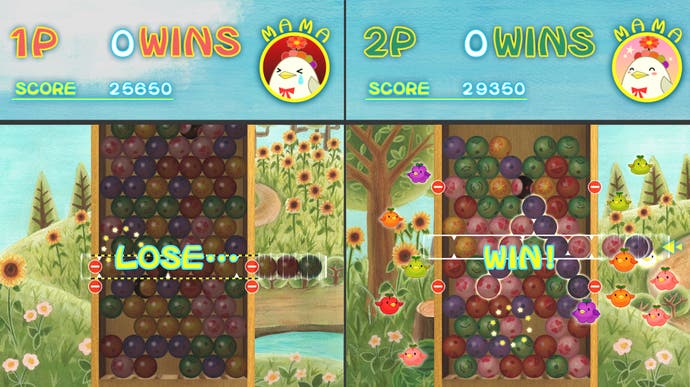Piyotama
Much l'oeuf.
When John Walker said Slitherlink was completely brilliant, he identified one of its advantages over Sudoku as the ability to complete complex puzzles without having to juggle all sorts of values and variables in your head. But that's not to say the opposite can't be rewarding, as Piyotama - a cute little puzzle game released on the US PlayStation Store at the start of August - happily proves.
Superficially similar to the average falling-blocks puzzler, the object is to line up four balls (eggs, if you want to be pedantic about it) horizontally or diagonally. This initiates a combo period, during which you can line more up (including those involved in the initiating line, if you like) to multiply your points income when the combo period ends and the balls crack and disappear.
However, you line them up not by rotation or substitution, but by sliding one row at a time horizontally so that three of the balls protrude over the left or right edge of the play area. You are then able to reorder these three balls and reinsert them, either on the same row or, if you press up or down, on one of the higher or lower ones. Sounds complex, but if you glance at the screenshots you should be able to grasp what we mean.
Anyway, as a result of this, manipulating balls near the sides is intuitive, but getting to the ones in the centre is trickier, and requires a finer understanding of the ripple effect caused by your initial manoeuvres. Another restriction is that when your slider is off the right-hand side, your next slider movement has to be to the left, and vice versa - a bit like a typewriter platen.
Now, where this relates to our original point is that you are often faced with partial solutions that you have to sort of screw up slightly in order to affect the full solution. To put it another way, consider a Rubik's Cube where you have lined up 8 of the 9 blue squares on one side, and getting the 9th into place has to involve rotating some of the others away from their final resting places. Piyotama proposes similar dilemmas: sometimes the only way to solve the problem of getting a blue ball to the top of a diagonal chain of three blue balls is to break up the initial three and then come back and restore them later.

Except it's not quite that complicated. Instead, it slots in neatly somewhere between the Slitherlink and Rubik extremes. Once you're proficient at manoeuvring balls around the play area, doing and undoing formative self-harm, you find yourself having a lot of fun doing so - particularly as your actions have the added benefit of appearing to be complete voodoo to unfamiliar observers.
Piyotama also makes clever use of the poor, maligned little Sixaxis. You can slap it against your palm to prematurely crack balls and end a combo, and you can shake it to jumble up some of the higher balls, which works well due to convincing physics, and sometimes gets you out of a hole if the screen is filling up and you're in a panic.
One fault is your ability to randomly achieve success by making panic slides as the screen fills up, particularly in multiplayer, which calls to mind the "scrubbing" you could get away with in DS puzzler Meteos. It's not quite as beneficial as that, but it's in the same area, and slightly detrimental to the whole - even if there was no obvious way for JapanStudio to impede it by design.
A bigger problem, we reckon, is that Piyotama's principles are a bit wasted on the traditional falling blocks set-up. There's a high-score mode and an endless mode, and the former feels as though it's over too quickly, while the latter becomes tedious due to a lack of urgency, with elements like blocker balls which prevent you from sliding particular rows still not enough to put you in much sustained danger, even after a solid hour of cracking eggs.

It feels like it could have done with learning the lessons of Lumines, really. Lumines isn't an amazingly complex set of rules, and becomes quite boring through simple repetition (as a single-skin rotation will demonstrate quickly), but the clever way the main game alters gameplay conditions and tempo every few minutes keeps it interesting and sidesteps the mistakes of other puzzle games that simply ramp up to a crescendo of difficulty and then dump you back to the menus.
Coupled to a set-up like that, the magical and rewarding art of being ace at Piyotama - something that won't take overly long to pick up - could have been essential. Instead, this is more of a curiosity for fans of puzzle games, and people who like to see things done differently, with a bit of potential to entertain if you get wrapped up in multiplayer and leaderboards.
It's dirt-cheap, too - just USD 2.99 in Americaland, and that's how you'll have to play it for now, as there's no word on a UK release. Hopefully that will change, because this is definitely the sort of game PSN should be cultivating. A sequel that maintains the underlying mechanisms and looks beyond Tetris for context could be the next Lumines. That's not even hyperbole. So, how about it, Sony?

